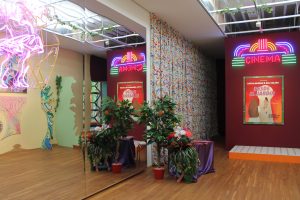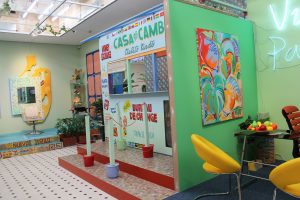
Second year BA (Hons) Visual Culture student Ella Winning on an eye-opening course trip to Germany
Back in November, twelve of my course mates and I spent five days in Berlin as part of the second-year Trip to Europe module. During this time, we visited many of the famous tourist sights such as the Reichstag, Berlin Wall and the Bauhaus Archive, as well as galleries and museums in the city.
One place that particularly caught my attention was the Hamburger Bahnhof; a contemporary art museum situated in the west of Berlin. Hosting a collection of modern art works by the likes of Andy Warhol, Roy Lichtenstein and Anselm Kiefer, the exhibition I was most drawn to was the Preis der Nationalgalerie (29 September 2017 – 14 January 2018). This is a biennial opportunity for four artists under the age of 30 who live and work in Berlin to exhibit their work in a group exhibition at the Museum. Additionally, one of them is chosen to be the focus of a solo show and publication. The most recent shortlisters were Sol Calero, Iman Issa, Jumana Manna, and Angieska Polska.
As part of the show, Venezuelan-born multidisciplinary artist Sol Calero exhibited her interactive installation, Amazonas Shopping Center; a brightly coloured amalgamation of a selection of her works from the past five years. Throughout her work, the artist explores themes of national identity and ethnicity, especially in terms of her own, Latino background. Calero does this through her incorporation of various features of Latin culture; her installation includes a hairdressing salon (background of figure 2), travel bureau, consisting of a currency exchange kiosk and travel agency desk (mid and foreground of figure 2), cybercafé, school, and a salsa dance studio and cinema where her telenovela, Desde el Jardin, plays (figure 3).
While Calero is frequently labelled as a ‘Latin’ artist, the artist and her fellow prize entrants reject the practice of describing of them and their work in terms of their ethnicity. In a statement released to Artnet News, the artists
explained that they felt their minority backgrounds as immigrants and as women were ‘emphasized much more heavily than the content of their work’ during promotions and advertising for the exhibition.[1] I found this particularly interesting; at a time of changing attitudes towards race in terms of politics (and therefore society), is it even relevant for the nationalities of the artists to be highlighted? Is exercising of nationality allowing pride in ‘otherness’, or is it a tool of isolation which discourages inclusion?
Some might argue that the Museum was simply highlighting diversity in the selection of artists, showing the all-encompassing attitudes towards art, while others (agreeing with the artists themselves) may perhaps argue that the Museum’s focus on the ‘otherness’ of the four women was perhaps a ‘self-congratulatory use of diversity as a public relations tool’[2] for the Hamburger Bahnhof, prohibiting the artists from fully integrating into the German art world.
It can be assumed that the Museum, along with many other organisations across Germany, wish to reject the racist politics that made a resurgence at the start of the twenty-first century, along with far-right intolerance emerging around the globe in the modern day. The renunciation of these politics can clearly be seen in modern German culture; one example being Angela Merkel’s pioneering and controversial open border policy introduced in 2015. [3] It could be argued that, with similar intentions to Merkel, the Museum has consciously tried to denounce intolerance by highlighting or celebrating the differences of the entrants to those of the past. Others might find it patronising and a form of discouraging inclusion to the ‘German’ art world.
I found this trip interesting because it opened my eyes to this issue of nationality and its relevance in the culture not only of Berlin, but of the contemporary world; a topic which will continue to be particularly important in the years to come.
[1] Kate Brown, “These Four Artists Were Nominated for Germany’s Foremost Art Prize—and Now They’re Denouncing It” ArtNet News.
[2] Brown, “These Four Artists Were Nominated for Germany’s Foremost Art Prize—and Now They’re Denouncing It”
[3] Reuters in Berlin “Merkel: no regrets over refugee policy despite political cost” Guardian. Web. 27 Aug, 2017.



